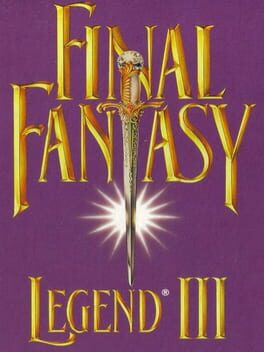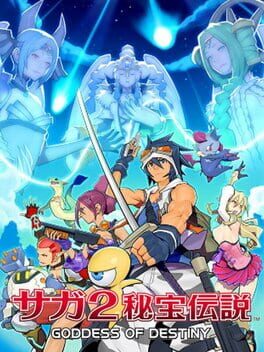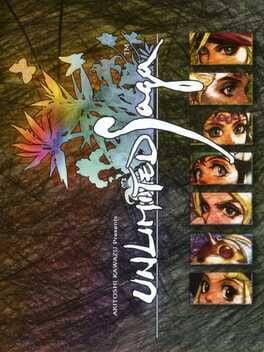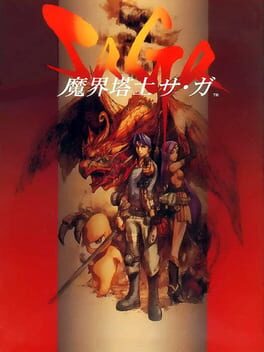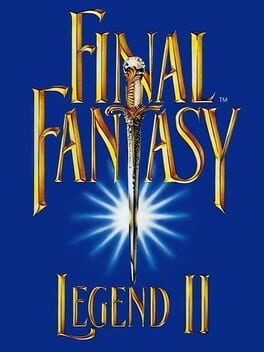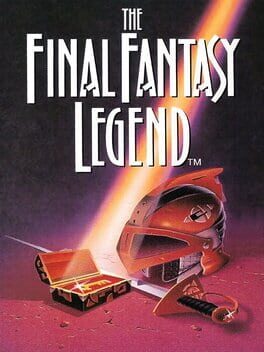

Millennia ago, a fierce battle was waged for control of an idyllic world known as Pureland. After much fighting, the brave warriors of Pureland were protectively sealed in their own dimension, away from the rest of the universe. This was done by means of Talon, a powerful space craft capable of traveling through both time and space. Centuries have passed and the would-be master of Pureland have managed to create a rift in the galaxy, sending the Pureland Water Entity to devour all that stands in its path. You must journey through past, present, and future to find the 13 pieces of the now-divided Talon. Only then can you save the universe from total destruction.
Also in series
Reviews View More
Final Fantasy Legend III is a unique and ambitious early JRPG that offers a time-traveling adventure with unconventional mechanics. You'll customize your party with humans, mutants, and even transforming monsters, exploring diverse worlds across the past, present, and future. While marred by some frustrating design choices and an occasionally steep difficulty curve, Final Fantasy Legend III possesses a surprising amount of depth and rewards those who persevere with its charming story and experimental systems.
Still very much in the mood for old RPGs after SaGa 2, I got right to work on completing the last of the GameBoy SaGa games. I bought this collection on Switch well over a year and a half ago, and I figured it was high time I actually finished the darn thing x3. I didn’t know much about this game going in other than that it wasn’t really a SaGa game beyond the title. The creator of SaGa had already been pushed on to Romancing SaGa by this point, so the team that put this together were largely the team that would go on to make Final Fantasy: Mystic Quest, and this game was something of a prototype for that game in many ways with how much they share mechanically. At any rate, after all of the wikis I’ve needed to consult and countless stats I’ve needed to keep track of playing other SaGa games recently, I was honestly happy to have something more straightforward to play XD. It took me around 15~20 hours to beat the Japanese version of the game via the Switch SaGa collection over the course of a week (without using the collection’s speed up features).
SaGa 3’s story is very involved and complicated right out the gate. Years ago, a large pot appeared in the sky and began to pour water and monsters out into the world. Within a couple of decades, the world was completely submerged underwater and monsters had destroyed anything that was left afterwards. In a hope to prevent this awful fate, three young heroes were sent back in time to train for the day they’d be able to try and save their doomed world. Their leader, Dune, is our main character, and our story begins on the day their training is complete and they set out on their quest.
The story honestly goes tons of weird places after that, and there are tons of other named NPCs and places throughout the story that you’ll need to keep track of throughout your time-hopping and dimension-hopping adventure. Heck, the other three player characters all have names and roles as well! That said, none of it really matters much. The story is quite complicated compared to the previous SaGa games on GameBoy, sure, but not to much end. It’s a story where a ton of Stuff (TM) occurs, but it’s mostly just for the sake of giving the player a Next Location to progress on to. A decent deal of it is probably me playing this in Japanese rather than English, but I found the story quite difficult to follow, myself, though I gave up caring all that much about it pretty quickly. The dialogue writing is pretty flat, and beyond that, it’s a pretty bog-standard good vs. evil story that happens to have a somewhat novel setting for the time. While that’s not exactly a point against it, it’s not really a point in its favor either.
The mechanics are indeed much more straightforward than a typical SaGa game, and they’re downright nearly as simple as they could possibly be, quite frankly. You’ve got a party of four members, two physical attack-focused and two magic-focused, and you gain experience points from leveling and a level up will give you a general boost to your stats. It’s damn near as simple as a turn-based RPG like this comes, honestly. There are some annoying nuances and lacking of information regarding what strengths weapons actually have, but nothing terribly unique for the time.
To give the game at least a little credit, however, it does try to have some SaGa-y mechanics by adapting the monster system from the previous two games. While you can’t have any monsters in your group like you could in SaGa 1 and 2, you can instead have your human and esper party members eat meat or use robot parts dropped by defeated enemies to transform into monster hybrids and cyborgs respectively. Eating the opposite type you currently are will turn you back to normal, and there are some dedicated purification spots to do it at as well if you’re having trouble with that. Becoming a monster or cyborg makes your equipment act differently as well as gives you some special abilities (that are different from spells) depending on what you’ve turned into, and they even shift around your base stats to boot.
Neat as all that is, it’s a pretty poorly implemented system that I never engaged with much. Even if you don’t eat more meat or equip more cyborg parts, you can still shape shift after a random battle into a new form, meaning you can’t reliably maintain a particularly useful monster or cyborg form should you find one. It makes your party plagued with unreliable side-grades and down-grades in how it affects your stats and max HP, and I found it a perfectly viable strategy to just ignore that stuff the entire game and stick with a more stable normal form party. I’ve got to give a little bit of credit where credit is due for implementing such an involved system in the game, but I really wish they’d gone through the extra effort to make the stuff actually feel like it was worth using at all.
The presentation is, at least, quite nice and doesn’t let down its predecessors. The music compositions aren’t quite as nice, in my reckoning anyhow, but it’s still another GameBoy RPG full of good music. The graphics are also quite nice, and while there weren’t any as stand-out memorable as there were in SaGa 2, there were still a lot of neat, silly bad guy sprites to fight along the journey.
Verdict: Not Recommended. This isn’t a bad game, per se, but it’s one I find basically impossible to recommend you spend your time with. The story is dull, the mechanics are bland, the signposting is quite bad, the difficulty is quite easy, and it’s not particularly outstanding in its presentation either. You might not have a bad time with SaGa 3, and the mechanics might frustrate you a bit less than SaGa 1 and 2 on the GameBoy did, sure, but at least SaGa 1 and 2 (for all their faults) were novel and interesting in many ways. SaGa 3 may’ve been perfectly acceptable when it came out, but I think it’s very hard to justify spending time with in 2024 unless you simple must experience every SquareSoft game that’s out there out of pure intellectual curiosity.
SaGa 3’s story is very involved and complicated right out the gate. Years ago, a large pot appeared in the sky and began to pour water and monsters out into the world. Within a couple of decades, the world was completely submerged underwater and monsters had destroyed anything that was left afterwards. In a hope to prevent this awful fate, three young heroes were sent back in time to train for the day they’d be able to try and save their doomed world. Their leader, Dune, is our main character, and our story begins on the day their training is complete and they set out on their quest.
The story honestly goes tons of weird places after that, and there are tons of other named NPCs and places throughout the story that you’ll need to keep track of throughout your time-hopping and dimension-hopping adventure. Heck, the other three player characters all have names and roles as well! That said, none of it really matters much. The story is quite complicated compared to the previous SaGa games on GameBoy, sure, but not to much end. It’s a story where a ton of Stuff (TM) occurs, but it’s mostly just for the sake of giving the player a Next Location to progress on to. A decent deal of it is probably me playing this in Japanese rather than English, but I found the story quite difficult to follow, myself, though I gave up caring all that much about it pretty quickly. The dialogue writing is pretty flat, and beyond that, it’s a pretty bog-standard good vs. evil story that happens to have a somewhat novel setting for the time. While that’s not exactly a point against it, it’s not really a point in its favor either.
The mechanics are indeed much more straightforward than a typical SaGa game, and they’re downright nearly as simple as they could possibly be, quite frankly. You’ve got a party of four members, two physical attack-focused and two magic-focused, and you gain experience points from leveling and a level up will give you a general boost to your stats. It’s damn near as simple as a turn-based RPG like this comes, honestly. There are some annoying nuances and lacking of information regarding what strengths weapons actually have, but nothing terribly unique for the time.
To give the game at least a little credit, however, it does try to have some SaGa-y mechanics by adapting the monster system from the previous two games. While you can’t have any monsters in your group like you could in SaGa 1 and 2, you can instead have your human and esper party members eat meat or use robot parts dropped by defeated enemies to transform into monster hybrids and cyborgs respectively. Eating the opposite type you currently are will turn you back to normal, and there are some dedicated purification spots to do it at as well if you’re having trouble with that. Becoming a monster or cyborg makes your equipment act differently as well as gives you some special abilities (that are different from spells) depending on what you’ve turned into, and they even shift around your base stats to boot.
Neat as all that is, it’s a pretty poorly implemented system that I never engaged with much. Even if you don’t eat more meat or equip more cyborg parts, you can still shape shift after a random battle into a new form, meaning you can’t reliably maintain a particularly useful monster or cyborg form should you find one. It makes your party plagued with unreliable side-grades and down-grades in how it affects your stats and max HP, and I found it a perfectly viable strategy to just ignore that stuff the entire game and stick with a more stable normal form party. I’ve got to give a little bit of credit where credit is due for implementing such an involved system in the game, but I really wish they’d gone through the extra effort to make the stuff actually feel like it was worth using at all.
The presentation is, at least, quite nice and doesn’t let down its predecessors. The music compositions aren’t quite as nice, in my reckoning anyhow, but it’s still another GameBoy RPG full of good music. The graphics are also quite nice, and while there weren’t any as stand-out memorable as there were in SaGa 2, there were still a lot of neat, silly bad guy sprites to fight along the journey.
Verdict: Not Recommended. This isn’t a bad game, per se, but it’s one I find basically impossible to recommend you spend your time with. The story is dull, the mechanics are bland, the signposting is quite bad, the difficulty is quite easy, and it’s not particularly outstanding in its presentation either. You might not have a bad time with SaGa 3, and the mechanics might frustrate you a bit less than SaGa 1 and 2 on the GameBoy did, sure, but at least SaGa 1 and 2 (for all their faults) were novel and interesting in many ways. SaGa 3 may’ve been perfectly acceptable when it came out, but I think it’s very hard to justify spending time with in 2024 unless you simple must experience every SquareSoft game that’s out there out of pure intellectual curiosity.
Easily the weakest of the first set of SaGas that I've played so far, but that doesn't make it actually bad. This one wasn't really mechanically interesting so I didn't feel much like messing with the complicated shape changing system, but there's a charm to that. I'm sure there's people who've been through with the all robot party or what have you and that probably articulates in some new ways. I don't give a shit I wanna replay II instead.
I do think that most of the mechanical space of the design that started in FF2 was kind of exhausted and the director was different so there was an attempt to experiment in various ways. Most of those ways just end up circling back to making it more like a Dragon Quest, with character progression being handled via levelling up and the differences in weapon classes being nullified. You always have to have two physical characters and two magic characters and anyone can learn anything and there's no real reason for them not to. This would be the better one if you're a kid who can't wrap your head around the mechanics of the previous games but it's pretty disappointing for me now.
Storywise, it's also a lot less bold, but not without some cool ideas. The first half of the game is all about how your characters were sent to the past to like, grow up into protagonists and fight the bad guy, who is flooding the world. They don't do as much as you'd want with the concept, but you do get to travel the same world in three time periods and watch it change, like an early look at concepts that'd be more fleshed out in Chrono Trigger and probably other games. It's not MUCH but it stands out.
The second half of the game has you flying your own spaceship around, finding parts to upgrade it and crew to staff it. This is fun in the way that any RPG with a similar mechanic is fun, and it pays off more than you'd expect at the very end when the ship flies in to help you fight the final boss. Again, this will be done better in later games but it's here and it's enough of a draw to keep me going.
Also the enemy sprites are still just top tier. There's so many weird mouth monsters in this one holy hell it whips. Mouthy flesh wads for days. Bless them. Oh also being able to jump is a real innovation in the area of 'an npc has blocked me from going down this path and I have to wait for the rng to move it'.
I do think that most of the mechanical space of the design that started in FF2 was kind of exhausted and the director was different so there was an attempt to experiment in various ways. Most of those ways just end up circling back to making it more like a Dragon Quest, with character progression being handled via levelling up and the differences in weapon classes being nullified. You always have to have two physical characters and two magic characters and anyone can learn anything and there's no real reason for them not to. This would be the better one if you're a kid who can't wrap your head around the mechanics of the previous games but it's pretty disappointing for me now.
Storywise, it's also a lot less bold, but not without some cool ideas. The first half of the game is all about how your characters were sent to the past to like, grow up into protagonists and fight the bad guy, who is flooding the world. They don't do as much as you'd want with the concept, but you do get to travel the same world in three time periods and watch it change, like an early look at concepts that'd be more fleshed out in Chrono Trigger and probably other games. It's not MUCH but it stands out.
The second half of the game has you flying your own spaceship around, finding parts to upgrade it and crew to staff it. This is fun in the way that any RPG with a similar mechanic is fun, and it pays off more than you'd expect at the very end when the ship flies in to help you fight the final boss. Again, this will be done better in later games but it's here and it's enough of a draw to keep me going.
Also the enemy sprites are still just top tier. There's so many weird mouth monsters in this one holy hell it whips. Mouthy flesh wads for days. Bless them. Oh also being able to jump is a real innovation in the area of 'an npc has blocked me from going down this path and I have to wait for the rng to move it'.
